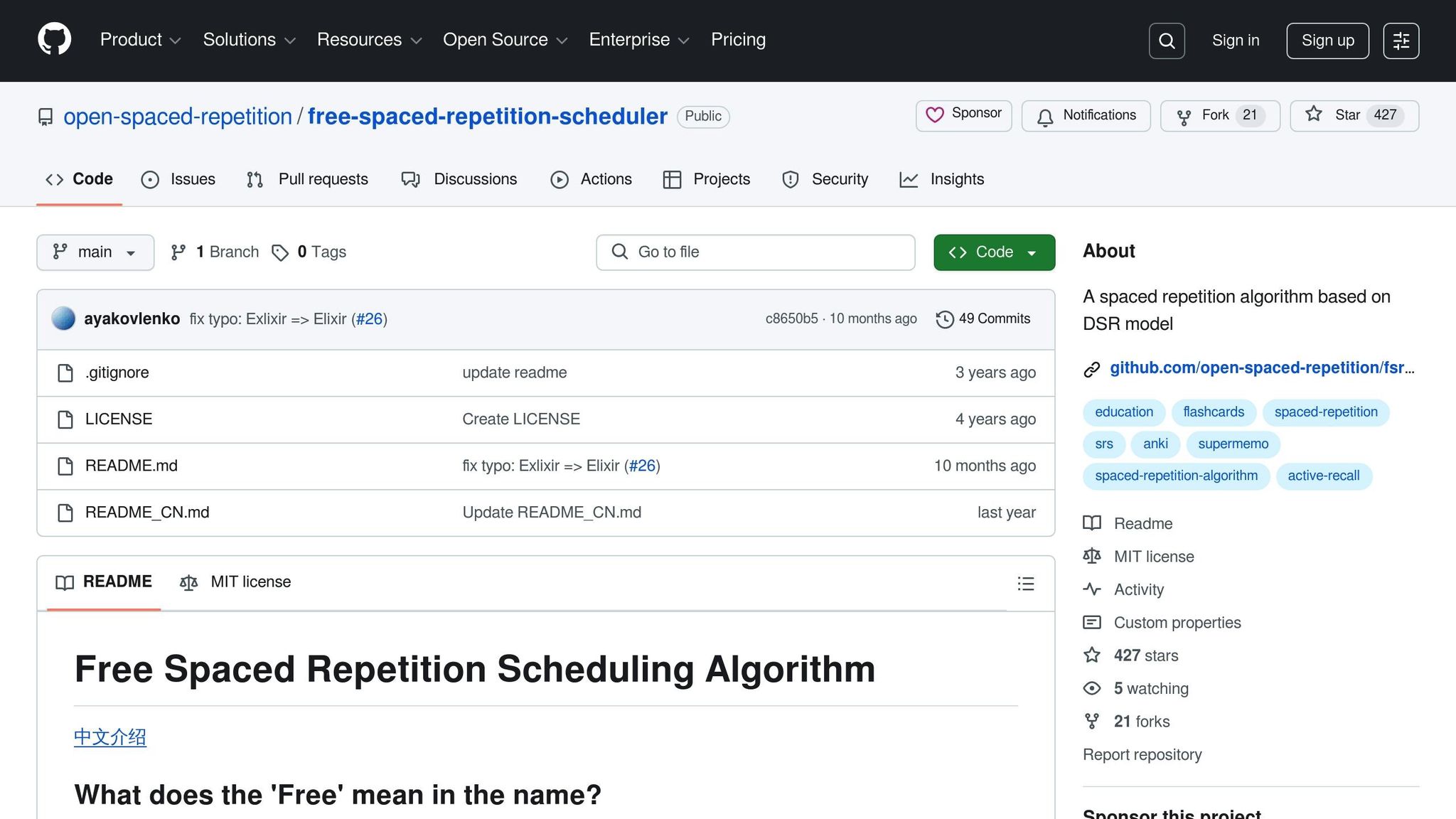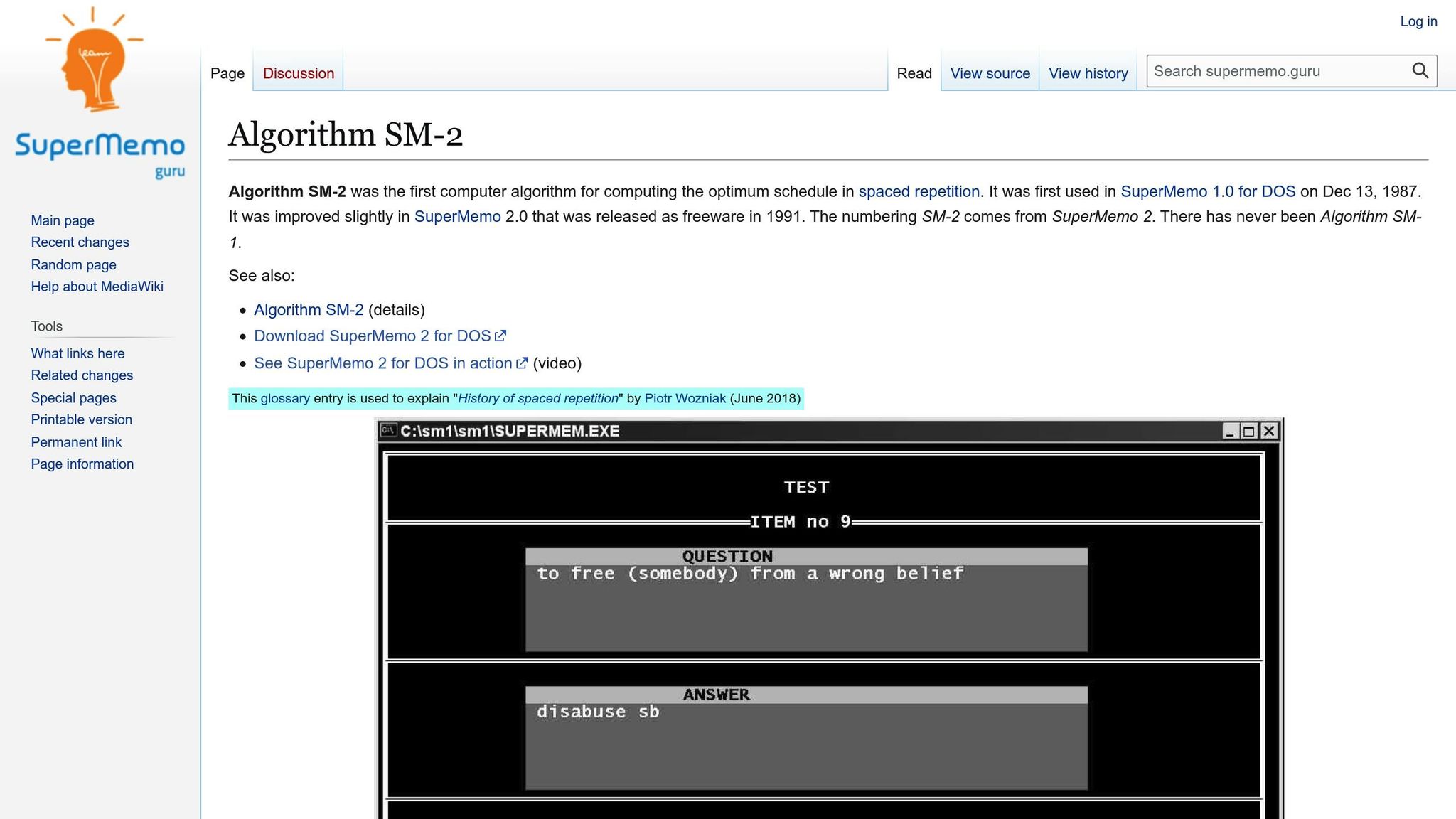
FSRS Algorithm: Next-Gen Spaced Repetition
Want to learn better and faster? FSRS (Free Spaced Repetition Scheduler) is a new system that improves memory retention by personalizing study schedules. Unlike older methods like SM-2 and Anki, FSRS uses machine learning to predict the best times for reviewing material, cutting down on unnecessary repetition while maintaining high retention rates.
Key Benefits of FSRS:

- Personalized Learning: Adapts to your memory patterns using advanced metrics.
- Fewer Reviews: Reduces reviews by 20% while keeping retention rates high.
- Smart Scheduling: Dynamically adjusts intervals based on how well you recall.
Quick Comparison: FSRS vs. SM-2/Anki

| Feature | FSRS | SM-2/Anki |
|---|---|---|
| Memory Modeling | Tracks memory stability, retrieval strength, and spacing effect | Basic interval calculations |
| Scheduling Precision | Dynamic, probability-based | Fixed formulas |
| Review Efficiency | Higher, fewer reviews needed | Lower, more reviews needed |
FSRS is designed for anyone serious about optimizing study time - students, professionals, or lifelong learners. It’s a smarter way to learn and retain information.
1. How FSRS Works
Understanding Learning Patterns
FSRS uses machine learning and statistical tools to figure out how each individual learns best. It looks at factors like how quickly you respond, how accurately you recall information, and how complex the material is. With this data, the system builds a unique learning profile for you.
Adapting Study Schedules
Once FSRS understands your learning habits, it adjusts your study schedule in real-time. It uses a memory decay curve - a mathematical model predicting when you're likely to forget something - to decide the best times for review. This flexible system ensures your study sessions stay effective as your learning progresses.
Breaking Down Memory Data
FSRS focuses on three key memory factors:
- Memory stability: How well you retain information over time.
- Retrieval strength: How easily you can recall what you've learned.
- Spacing effect: The ideal time intervals between reviews.
By combining these elements, FSRS creates a detailed picture of how your memory works. This allows the system to predict exactly when you need to review specific content, leading to more effective study sessions.
Results and Efficiency
The system prioritizes material that’s harder for you over topics you’ve already mastered, ensuring high retention rates with fewer reviews overall. Unlike older systems that stick to fixed intervals, FSRS offers a more efficient and tailored learning experience.
FSRS vs SM2: How Spaced Repetition Algorithms Work
2. SM-2 and Anki Systems
Understanding these well-known algorithms helps highlight the improvements FSRS introduces to spaced repetition.
Learning Pattern Analysis
SM-2 offers six response options for recall evaluation, while Anki simplifies this with just four. These differences influence how each system schedules reviews and adapts to user performance.
Study Schedule Adjustment
| Feature | SM-2 | Anki |
|---|---|---|
| Initial Intervals | Fixed | User-customizable |
| Late Review Handling | No adjustment | Adjusts next interval |
| Failed Card Treatment | Reset | Reduces interval |
| Ease Bonus | None | Applied for easy recalls |
SM-2 relies on fixed intervals, creating a more rigid study schedule. On the other hand, Anki allows users to tailor the initial learning process, offering greater flexibility in managing study sessions.
Memory Data Processing
Anki builds on SM-2 by introducing additional features. For instance, when a user marks a card as "remembered easily", Anki applies a bonus to the interval calculation, extending the time before the next review. Moreover, Anki’s handling of repeated failures is less punitive, as it avoids drastically reducing the card's ease factor with each mistake.
Results and Success Rates
Anki stands out in its ability to manage delayed reviews by adjusting future intervals accordingly. Both systems, however, depend on fixed mathematical formulas to calculate review intervals. This reliance can limit their adaptability to individual learning patterns. Anki’s forgiving approach to failed reviews helps users stay on track, even with more challenging material.
sbb-itb-1e479da
Key Differences Between FSRS and Other Methods
FSRS takes spaced repetition to the next level by introducing several improvements that set it apart from traditional systems. Let’s break down what makes FSRS stand out.
Memory Model Implementation
FSRS uses the "Three Component Model of Memory", which tracks individual memory patterns in a way older systems simply don’t. This approach represents a major upgrade from traditional methods.
| Aspect | FSRS | Traditional Systems (SM-2/Anki) |
|---|---|---|
| Memory Modeling | Three Component Model | Basic interval calculations |
| Pattern Recognition | Personalized learning curves | Fixed formulas |
| Scheduling Precision | Dynamic, probability-based | Fixed mathematical rules |
| Long-term Adaptation | Dynamic adaptation | Static progression |
This enhanced memory modeling allows FSRS to predict the best times for review with incredible accuracy.
Prediction Accuracy
One of FSRS’s standout features is its ability to predict review timing with greater precision. Unlike traditional systems that rely heavily on user feedback to adjust intervals, FSRS incorporates multiple factors to fine-tune its scheduling dynamically. Importantly, FSRS doesn’t alter the initial learning or relearning steps, keeping the short-term learning process familiar while enhancing long-term scheduling.
Performance Metrics
FSRS brings advanced metrics into the mix to improve review efficiency and accuracy:
| Metric | Purpose | Range |
|---|---|---|
| Log Loss | Measures prediction accuracy for reviews | 0 to infinity (lower is better) |
| RMSE | Tracks overall prediction performance | 0 to 1 (lower is better) |
| Review Efficiency | Assesses time spent vs. retention | Varies by user |
For example, FSRS uses log loss to evaluate individual review outcomes, enabling it to fine-tune predictions more effectively than older systems. These metrics highlight FSRS’s ability to deliver a more efficient and personalized learning experience.
Practical Implementation
FSRS integrates seamlessly into existing study routines by focusing on long-term scheduling. By predicting exactly when information needs reinforcement, it ensures users spend their time reviewing material that matters most. This targeted approach helps learners maximize their study efforts without disrupting familiar workflows.
Conclusion
FSRS introduces a new level of personalization to review schedules, offering a smart way to align study intervals with individual learning patterns. By fine-tuning review timing, it minimizes unnecessary repetition and maximizes retention, making it especially useful for periods of intense study or exam preparation.
QuizCat AI takes this innovation further by integrating FSRS into its platform. This means learners receive study materials at the most effective moments, boosting long-term memory retention. It’s a clear example of how AI is reshaping personalized learning.
The data speaks for itself - FSRS consistently delivers accurate predictions and lower log loss values. This makes it an invaluable tool for:
- Students juggling multiple subjects with varying levels of complexity
- Professionals needing to stay updated in fast-changing industries
- Anyone looking to make the most of their study time while improving retention
What truly sets FSRS apart is its combination of dynamic memory modeling and precise scheduling algorithms. Unlike basic spaced repetition systems, FSRS adapts to the unique memory patterns of each user, all while staying grounded in scientific principles. It’s a game-changer for anyone serious about optimizing their learning.
FAQs
How does the FSRS algorithm improve study schedules using machine learning compared to traditional spaced repetition methods?
The FSRS algorithm uses machine learning to study your learning behaviors, retention patterns, and performance over time. Unlike standard spaced repetition techniques that rely on fixed review intervals, FSRS adapts your study schedule in real time, aligning with your unique pace and memory trends.
This customized method ensures you revisit material at the best possible moment, helping you remember it for longer while making your study sessions more efficient. By fine-tuning the process to suit your individual needs, FSRS elevates spaced repetition into a smarter, more tailored tool for learning.
How does the FSRS algorithm decide the best times to review different types of material?
The FSRS algorithm relies on key metrics such as log loss and custom root mean square error (RMSE) to evaluate how effectively you're retaining information. By monitoring these metrics, it determines the ideal intervals for reviewing specific content, ensuring you revisit material when it's most beneficial for reinforcement.
This method leverages data to fine-tune your learning process, helping you retain knowledge more efficiently and strengthen long-term memory.
How does the FSRS algorithm improve memory retention while reducing study time?
The FSRS algorithm (Fast Spaced Repetition Scheduling) is designed to make learning smarter and more personalized. It adjusts review intervals based on how well you remember specific items, ensuring you revisit material right before it slips from memory.
This approach cuts down on extra repetitions, letting you focus on what truly needs attention. As a result, you can retain information for longer periods while dedicating less time to studying. It's a method that streamlines your learning process and helps you get more out of your efforts.
